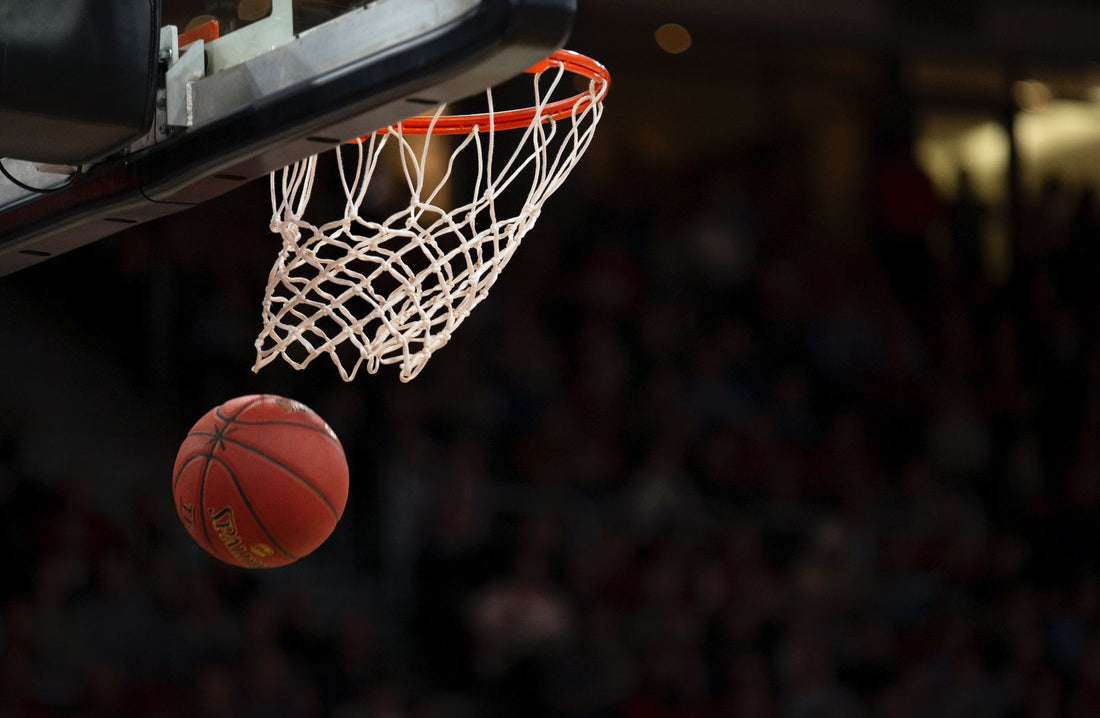
History of Basketball: A Complete Timeline
Share
From basketball’s humble beginnings in a small gymnasium to its rise as a global phenomenon, the sport has captivated millions of fans worldwide.
But what did it take for basketball to become the cultural touchpoint it is today? Here, we’ll unravel the history of basketball, including its origins, growth, and impact on the world of sports and society.
So, lace up your sneakers and grab your basketball because we’re about to dribble back in time.
James Naismith Invents Basketball
James Naismith, a 30-year-old Canadian physical education instructor, invented basketball in 1891. Having a passion for sports, he wanted to create a new game that his students at the International YMCA Training School in Springfield, Massachusetts, could play indoors during the harsh winter months.
Drawing inspiration from various other games and sports, Naismith set out to develop a game that would be exciting and promote teamwork. After much contemplation, he finalized the original 13 rules of basketball.
On December 21, 1891, Naismith hung a peach basket at each end of the gymnasium balcony and divided his students into two teams. He told them the objective was to throw a soccer ball into the opposing team's peach basket while following the established rules.
Some of the original rules included:
- A player may throw the ball in any direction with one or both hands.
- A player cannot run with the ball but must throw it from where they catch it.
- A player must hold the ball in or between the hands, and the arms or body must not be used for holding it.
- A player may not shoulder, hold, strike, or trip an opponent.
- When a player hits the ball with their fist, violates the rules regarding holding it, or exhibits unsportsmanlike behavior, they commit a foul.
These original rules laid the foundation for the basketball game and have since evolved into the modern rules you see today.
High Schools Adopt the Sport
Naismith's creation quickly gained popularity, and it wasn't long before basketball began to spread beyond the walls of the YMCA Training School.
Physical education programs recognized the value of basketball as a team sport that children could play indoors, providing students with a competitive activity. Soon, basketball became a staple in school curriculums, and high schools nationwide began to incorporate the sport into their athletic programs.
Students from Chicago's Morgan Park Academy and the Chicago YMCA played the first high school basketball game in 1893 in Chicago. This marked the beginning of a new era for basketball. Soon, schools everywhere established leagues and tournaments, fueling the sport’s popularity even further.
Colleges Get in on the Game
Many colleges claim to have been a part of the very first college basketball game, with several matchups in the 1890s being strong contenders. However, the National Collegiate Athletic Association (NCAA) considers the first intercollegiate game to have occurred on February 9, 1895, when Hamline University faced off against Minnesota A&M (Minnesota won, 9-3).
The game gained attention and spread to other colleges, forming college basketball leagues and conferences. The annual NCAA basketball tournament, now known as “March Madness,” originated in 1939. Curiously enough, Henry V. Porter, an Illinois high school official, was the first to use the term March Madness that same year.
Of course, back then, only eight teams were eligible for the first NCAA Division I men’s basketball tournament. (Oregon beat Ohio State to become the tournament champion.) It has since become one of the most highly anticipated events in the sporting calendar.
The widespread adoption of basketball by high schools and colleges increased participation. It provided a platform for talented players to showcase their skills and attract attention from scouts and coaches. This, in turn, contributed to the overall development and evolution of basketball as a competitive sport.
Basketball Makes its Olympic Debut
One of the most significant milestones in basketball's international expansion was its inclusion in the Olympic Games. Men’s basketball made its Olympic debut in 1936 at the Berlin Summer Olympics. The United States dominated the tournament, winning the gold medal and propelling basketball toward becoming a global sport.
Since that introduction, basketball has remained a prominent event in the Games, captivating audiences worldwide. The Olympic basketball tournament has provided a platform for players from different nations to showcase their skills and compete internationally.
Over the years, various countries have emerged as basketball powerhouses, challenging the dominance of the United States and contributing to the growth and diversity of the sport. The participation of professional NBA players in the Olympics, starting with the "Dream Team" in 1992, further elevated the status of basketball on the global stage.
The Game Goes Global
Beyond the Olympics, basketball has experienced international expansion by establishing international basketball federations and tournaments.
Since its founding in 1932, the International Basketball Federation (FIBA) has been crucial in promoting and organizing international competitions. The FIBA World Cup, which sees national teams facing off every four years, showcases people's passion for the sport worldwide.
With the international expansion of basketball, the sport became a unifying force, transcending cultural and geographic boundaries. Its ability to bring groups together meant it was only a matter of time before players began to become professional.
Pro Basketball Takes Off
As basketball continued to capture the hearts of fans worldwide, the demand for professional competition grew. The National Basketball Association (NBA), the world's premier men's professional basketball league, started on June 6, 1946, as the Basketball Association of America (BAA). It later merged with the National Basketball League (NBL) in 1949 to form the NBA you know today.
The NBA season consists of regular-season games followed by playoffs, culminating in the NBA Finals, where the top teams from the Eastern and Western Conferences compete for the championship.
With high-flying dunks and intense competition, the NBA has captivated fans with its electrifying games and attracted the best basketball players worldwide. Players like Michael Jordan, Kobe Bryant, LeBron James, and many others have become sports icons.
Today, the NBA's popularity extends far beyond the United States, with a global fanbase and a presence in numerous countries through international broadcasts, partnerships, and exhibition games.
Women Establish Their Own League
In 1996, the Women's National Basketball Association (WNBA) established itself as the premier professional women's basketball league in the United States. Following a structure similar to the NBA, the WNBA season encompasses regular-season games that lead up to the playoffs and the WNBA Finals.
The WNBA has been instrumental in providing opportunities for female basketball players to showcase their skills at a professional level. As a platform for empowering women in sports, it’s also played a significant role in promoting gender equality in athletics overall.
The WNBA has produced such legendary players as Lisa Leslie, Diana Taurasi, and Maya Moore, who have inspired a new generation of female athletes.
Basketball Permeates Popular Culture
Basketball has become deeply ingrained in our culture, influencing music, fashion, and entertainment. From rap lyrics referencing iconic players to basketball-themed movies and TV shows, the sport is seemingly everywhere these days.
Musicians have often used basketball as a metaphor for success and determination. Artists like Jay-Z, Drake, and Kanye West have all incorporated basketball references into their lyrics, further solidifying the sport's presence in popular music.
Basketball’s reach also extends to fashion, inspiring unique styles and trends. From the sneakers players wear to the basketball jerseys that have become fashion statements, the sport has undeniably influenced modern streetwear and athletic apparel.
The drama involved in the sport has also played out on screens, serving as the focal point of numerous movies and documentaries. Films like "Hoosiers" (1986), "Space Jam" (1996), and "Coach Carter" (2005) have captured the imagination of audiences worldwide, further immortalizing the sport.
Communities Use the Sport for Good
Basketball has been crucial in community development, particularly in underserved areas. Local basketball courts have served as gathering places, fostering a sense of community and providing a safe space for individuals to engage in healthy competition.
In 2005, the NBA founded NBA Cares, the league’s global social responsibility program. According to the National Basketball Coaches Association website, NBA Cares has raised “more than $230 million for charity, provided more than 2.8 million hours of hands-on service, and built more than 860 places where kids and families can live, learn or play in communities around the world.”
Beyond NBA Cares, grassroots community programs have used basketball as a tool for social change, focusing on youth development, education, and empowering marginalized communities.
Basketball Breaks Barriers
Basketball has been instrumental in breaking down barriers and challenging stereotypes. In 1902, Harry “Bucky” Lew from Massachusetts became the first Black professional basketball player. Although he has never been inducted into the Basketball Hall of Fame, many continue to fight for his inclusion.
Since Lew’s time, many more players, such as Yao Ming, Dirk Nowitzki, and Jeremy Lin, have gone on to shatter stereotypes. The sport continues to provide opportunities for athletes from diverse backgrounds to showcase their talents and defy societal expectations.
Additionally, basketball has played a role in promoting gender equality in sports. While the pay disparity between the NBA and the WNBA remains significant, every decade brings progress in placing male and female players on more equal footing. Thanks to the achievements of female basketball players and the voices of those who support them, the WNBA has helped to shift societal perceptions and create opportunities for women in athletics.
Conclusion
Basketball's cultural and social impact continues to evolve, leaving an indelible mark on society. Through its fusion with popular culture, community development initiatives, and its role in breaking barriers, basketball has become more than just a game.
So, whether you're shooting hoops at home or cheering on your favorite team from the stands, maybe you’ll remember the remarkable history behind this beloved sport. May the game thrive, inspire, and bring joy to all participating.



